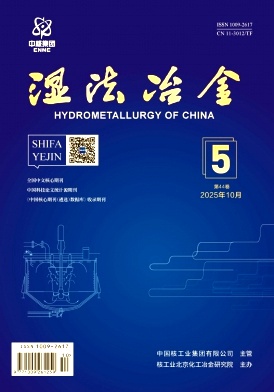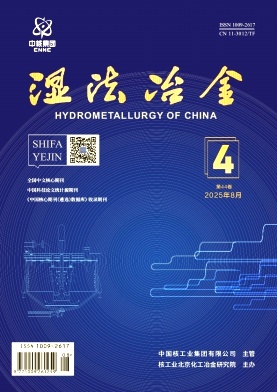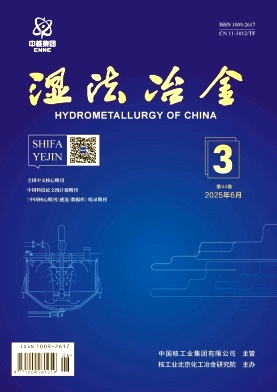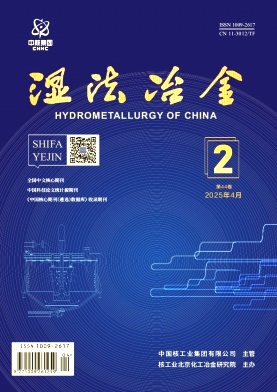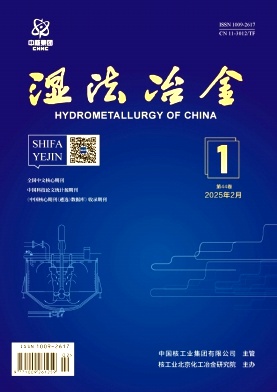Tracking the information about your manuscript
Communicate with the editorial office
Query manuscript payment status Editorial OfficeCollecting, editing, reviewing and other affairs offices
Managing manuscripts
Managing author information and external review Expert Information Expert ReviewOnline Review
Online Communication with the Editorial Department
Journal Display

Welcome to follow
Page Views
Page visits today: 600
Introduction

Hydrometallurgy of China (Bimonthly) was founded in 1982. It is a Core Journal of Chinese Journals, sponsored by China National Nuclear Corporation and Beijing Research Institute of Chemical Engineering and Metallurgy,CNNC.
Editorial mission: To disseminate scientific and technological information in the field of hydrometallurgy, facilitate technical exchanges, cultivate scientific and technological talents, and promote the transformation of scientific and technological achievements.
The journal main content covers the beneficiation and hydrometallurgical processes of non-ferrous metals, rare metals, dispersed metals, rare earth metals and precious metals. It is a comprehensive publication on hydrometallurgical technology, covering the synthesis processes of related materials (extractants, ion exchange resins, adsorbents, flocculants, etc.), automatic control systems for metallurgical processes, research and development technologies of equipment and instruments, analysis and testing methods, and processes for the treatment of three wastes and comprehensive recovery of secondary resources. It can be referred to by scientific research, design and production personnel engaged in metal ore beneficiation, hydrometallurgy, chemical engineering, comprehensive metal recovery, three-waste treatment, analysis and testing, and environmental protection, as well as teachers and students of relevant majors in colleges and universities.
The domestic unified serial number of Hydrometallurgy of China is CN11-3012/TF, the international standard serial number is ISSN 1009-2617, and the advertising license number is Jingtong Shijian Guangdengzi 20190002. It is edited and published by the editorial department of Hydrometallurgy of China, and distributed by the post office and the editorial department. The price is 15.00 yuan per issue and 90.00 yuan for the whole year. It can be subscribed to at any post office across the country. The distribution code is 80-181. The editorial department handles subscription services all year round.
Address: Editorial Board of Hydrometallurgy of China, No. 145 Jiushushu, Tongzhou District, Beijing, China
Tel: 8610-51675321 (Editor)
8610-51674124 (Subscription, Distribution)
E-mail: shifayejin@cnmstc.com
Website: https://sfyje.cbpt.cnki.net
Synergistic Extraction of Heavy Rare Earths Using Acidic Phosphine Mixed System
CHEN Luyan;ZHOU Jie;DENG Bicheng;KUANG Wangqiang;ZHOU Jieying;HUANG Yabin;KUANG Shengting;LIAO Wuping;The extraction and separation of heavy rare earths(HREs) by a mixed extraction system composed of N,N′-di(2-ethylhexyl)aminomethyl phosphonic acid mono-2-ethylhexyl ester(HEDEAP,H_2A2),2-ethylhexylphosphonic acid mono-2-ethylhexyl ester(P507,H_2B2) and n-heptane were investigated.The results show that the HEDEAP-P507 mixed system exhibits positive synergistic effects on HREs extraction.Under optimal conditions(HEDEAP molar fraction of 0.4,pH 2.0,phase ratio(Vo∶Va) of 1∶1 and temperature of 25 ℃),the maximum synergistic coefficient for Lu(Ⅲ) extraction can reach 1.42.The separation factors for Y/Ho, Er/Y,Tm/Er, Yb/Tm and Lu/Yb are determined as 1.67,1.76,4.5,1.67 and 2.11,respectively, surpassing those of the single P507 system.FT-IR analysis result reveals the participation of P—OH and PO groups in coordination reactions.Slope analysis indicates the possible formation of REH_3A_2B_2Cl2 as the synergistic complexes.The loading capacity of the mixed system containing 12 % HEDEAP and 18 % P507 for Lu(Ⅲ) is measured to be 32.4 g/L(calculated as Lu_2O3).The HREs loaded in the mixed system is easy to be stripping.The Lu(Ⅲ) stripping rate is 80% with 1.0 mol/L HCl, and the stripping acidity required for the same stripping rate is much lower than of P507 system(4.0 mol/L).Compared to the sole P507 system, the HEDEAP-P507 mixed system significantly enhances extraction selectivity for HREs while reducing stripping acidity requirements, demonstrating substantial scientific significance and promising application potential for selective separation of HREs.
Mineral Processing of Kamtor Gold Ore in Kyrgyzstan
YANG Fangyuan;DAI Shujuan;ZHOU Nan;GAO Ye;HU Zhigang;To enhance the resource utilization rate of fine-grained refractory gold ores, a combined process of flotation and leaching was studied for the extraction of gold from the Kamator gold ore in Kyrgyzstan(Au 3.07 g/t, Ag 20.40 g/t). The results show that a gold concentrate with a grade of 28.57 g/t can be obtained through closed-circuit flotation, with a gold yield and recovery rate of 8.05% and 72.47%,respectively, and the gold grade of the flotation tailings is 0.95 g/t.Under suitable conditions, the average gold leaching rate of the flotation tailings can reach 83.16%,with a relative gold recovery rate of 22.89% compared to the original ore, and the gold grade of the leaching residue is 0.16 g/t. By adopting the flotation-leaching process, the comprehensive gold recovery rate can reach 95.36%. This method can effectively recover gold from this type of ore.
Effect of Initial pH and Ore-Pulp Ratio on Bioleaching of A Sandstone Type Uranium Deposit
HUANG Zixian;LI Chunguang;LIU Zhenzhong;ZHANG Yaocai;LI Yongmei;TANG Yizi;During the biological leaching process, leaching microorganisms are relatively sensitive to environmental factors such as the initial pH and ore-pulp ratio.Taking a sandstone type uranium deposit in Inner Mongolia as the research object, by analyzing the pH,REDOX potential(Eh),iron ion concentration and uranium leaching rate of the leaching solution, the influence of the initial pH and ore-pulp ratio on the uranium leaching rate was discussed.The results show that when the initial pH is 1.4 and the ore-pulp ratio is 10%,the biological leaching effect of uranium is the best, and the uranium leaching rates reach 95.63% and 94.22%,respectively.An appropriate initial pH can reduce the formation of iron precipitation and maintain the activity of mixed Acidithiobacillus ferrous oxide(At.f) and Thiobacillus thiooxidans(T.t).The optimized ore-pulp ratio can enhance the mass transfer efficiency and promote leaching.The research can provide an important basis for optimizing the bioleaching process of sandstone-type uranium ores, and the research results can offer theoretical basis for the enhanced bioleaching of sandstone-type uranium ores in Inner Mongolia region.
Dissolution Kinetics of Tungstic Acid in Oxalic Acid Solution
LIANG Yong;PU Ting;CHEN Zanhong;LIU Yinliang;ZHANG Minghui;Jiangxi Provincial Key Laboratory of Green and Low Carbon Metallurgy for Strategic Nonferrous Metals;Aiming at the three wastes problem existing in the traditional hydrometallurgical tungsten smelting process, based on the analysis of the complexation coordination characteristics of oxalic acid and tungstic acid, the selective extraction of tungsten from crude tungstic acid using oxalic acid was studied.To clarify the dissolution reaction kinetics mechanism of tungstic acid in oxalic acid, taking pure tungstic acid as the research object and oxalic acid solution as the leaching agent, the dissolution rules of tungstic acid under different temperatures, oxalic acid concentrations and stirring speeds were investigated.The dissolution kinetics of tungstic acid in oxalic acid solution was studied by the equal leaching rate method.The results show that the apparent activation energy of this reaction is 48.9 kJ/mol.Controlled by the chemical reaction, the reaction order of oxalic acid concentration is 1.103 5.
Preparation and Electrochemical Performance of Li0.08La0.64Nb_2O6 Anode Material for Lithium-ion Batteries
LIAO Jie;LI Zhonglin;LU FengQi;The synthesis of micrometer-sized Li0.08La0.64Nb_2O6 anode material for lithium-ion batteries via a high-temperature solid-phase method was investigated and its structure and electrochemical properties were analyzed and discussed by X-ray powder diffraction(XRD) and cyclic voltammetry(CV).Structural characterization reveals that the material crystallizes in an orthorhombic system(space group Pmmm) and its ordered A-site defect layers, synergistically coupled with the rigid [NbO6] octahedral framework, construct percolating lithium-ion transport channels.Electrochemical testing results demonstrate that at a current density of 0.05 A/g, the material delivers a discharge specific capacity of 355.57 mAh/g after 100 cycles, with a capacity retention rate of 94.4%.The capacity retention remains at 84.9% after 3 000 cycles at a high rate of 1 A/g. Analysis of the pseudocapacitive contribution indicates a pseudocapacitive contribution rate of 88% at a scan rate of 1 mV/s. The kinetic index b ranges from 0.771 to 0.895,confirming that its charge storage mechanism is predominantly surface-controlled pseudocapacitance.Galvanostatic intermittent titration technique(GITT) measurements yield a lithium-ion diffusion coefficient of 5.79×10-11 cm2/s, indicating excellent ion transport capability. The research results can provide theoretical references for the development of A-site defective niobium-based perovskite materials and their application in lithium-ion batteries.
Deep Dealkalization of Vanadium Extraction Tailings via Calcification Transformation
YANG Xiaoying;ZHANG Weiguang;CAO Xuejiao;CHEN Yang;ZHANG Ting'an;Investigated the dealkalization of vanadium extraction tailings using calcium oxide. The effects of calcium oxide dosage, reaction temperature, reaction time, liquid-solid ratio, and stirring speed on the dealkalization efficiency were investigated, and the removal behavior of major metals during the dealkalization process was explored. The results indicate that under the optimal conditions of calcium oxide dosage 19%, reaction temperature 200 ℃, reaction time 60 min, liquid-solid ratio 2:1, and stirring speed 800 r/min, the dealkalization rate of the tailings reached 86%, with the Na2O content in the residue reduced to a minimum of 0.569%. Meanwhile, this process ensures relatively low removal rates for vanadium and chromium. The findings of the study can serve as a technical reference for the comprehensive resource utilization of vanadium extraction tailings.
[Downloads: 25 ] [Citations: 0 ] [Reads: 0 ] HTML PDF Cite this article
Preparation of V2O3 by Hydrogen Reduction of V-rich Solution Catalyzed by Raney Ni
LIU Wenbo;ZHANG Yimin;XUE Nannan;LIU Hong;ZHANG Liuhong;To enhance the reaction rate of V2O3 preparation via hydrogen reduction from v-rich solution, Raney Ni was synthesized by selectively leaching aluminum from a Ni-Al alloy using an alkaline leaching method. This Raney Ni was employed as a catalyst to improve the activation energy for the hydrogen reduction vanadium precipitation reaction. Characterization results from XRD, SEM, and BET indicate that the leaching of aluminum creates numerous pores and fissures, significantly increasing the specific surface area of the Raney Ni and providing abundant active sites for the hydrogen reduction vanadium precipitation reaction. Under the optimal conditions of a Raney Ni dosage of 10 g/L, a hydrogen partial pressure of 3 MPa, a reaction temperature of 250 ℃, a solution pH of 5, and a reaction time of 100 min, the vanadium precipitation rate reaches 99.84%. The Raney Ni demonstrates excellent cycling stability, after magnetic separation and five reuse cycles, the purity of the obtained V2O3 product remains stable at 99.27%. The apparent activation energy for the Raney Ni-catalyzed hydrogen reduction reaction is determined to be 96.254 4 kJ/mol, indicating that the hydrogen reduction process is primarily controlled by chemical reaction kinetics. Raney Ni catalyst exhibits effective vanadium precipitation performance, ease of magnetic separation, and high stability. The V2O3 product prepared via this catalytic hydrogen reduction method possesses high purity, offering a novel catalyst for hydrogen reduction vanadium precipitation.
[Downloads: 11 ] [Citations: 0 ] [Reads: 0 ] HTML PDF Cite this article
Optimization of Roasting-Leaching Process for Low-Grade Clay-Type Lithium Ore
ZHU Shan;ZHU Yanxia;ZHANG Chenhu;Due to its late discovery, wide distribution, large reserves, complex composition, and low grade, the comprehensive development and utilization of clay type lithium mines still lack systematic research.A systematic study was conducted on the optimization of enhanced leaching process parameters for clay type lithium ore in Liuzhi Special District, Liupanshui City, Guizhou Province. We investigated the roasting process conditions such as roasting temperature and time, as well as the effects of leaching process conditions such as leaching agent hydrochloric acid concentration, leaching temperature and time, stirring speed, and liquid volume to solid mass ratio on the experimental results. The experimental results show that roasting can destroy the crystal lattice of minerals such as kaolinite, superphosphate, diopside, and lithium chlorite in clay type lithium ores, which is beneficial for the sufficient contact between lithium containing phases and leaching agents during subsequent leaching processes, thereby improving their leaching efficiency; After high-temperature roasting at 600 ℃ for 90 min, the clay type lithium ore was subjected to optimal leaching conditions of 60 min, leaching temperature of 80 ℃, hydrochloric acid concentration of 4 mol/L, stirring speed of 400 r/min, and liquid volume to solid mass ratio of 6∶1.The lithium leaching rate can reach 93.48% and the leaching effect is good. The method does not require any additives during the calcination process, which can reduce pollution and lower costs. It has certain promotion and application value.
[Downloads: 29 ] [Citations: 0 ] [Reads: 0 ] HTML PDF Cite this article
Rhenium Recovery from Copper Smelting Acidic Wastewater: Global Research, Application, and Outlook
XU Guolong;YI Aifei;TIAN Ye;YUAN Yuan;ZHANG Chong;CAO Mingqian;As one of the globally strategic critical metals, rhenium often exists in copper ores in an associated form. Copper smelting waste acid, an important carrier of rhenium resources, exhibits complex characteristics including high acidity, high impurity content, and low rhenium concentration. The characteristics pose formidable challenges to the rhenium recovery process. The key technologies for rhenium recovery from waste acid, with a particular emphasis on the progress of advanced purification technologies targeting the leaching solution are systematically summarizes. The working principles, process optimization approaches, and industrial application effectiveness of solvent extraction and ion exchange methods are analyzed in depth. Moreover, the differentiated technical routes for leaching solution purification employed by major copper smelting enterprises worldwide are compared. Based on this, the key technical bottlenecks and potential breakthroughs for future development in this field are explored from multiple perspectives, including innovation of separation materials, process intensification, process integration, and secondary pollution control. The aim is to offer in-depth theoretical references and practical guidelines for the efficient, environmentally friendly, and high-value recovery of rhenium resources from waste acid.
[Downloads: 64 ] [Citations: 0 ] [Reads: 0 ] HTML PDF Cite this article
Leaching of Uranium and Thorium from Zirconium Metallurgical Waste Residue
ZHANG Tianpu;LIU Kang;WANG Guishuo;LIANG Gengyu;LIU Zhongchen;CHENG Hao;LIU Huiwu;XIANG Qiulin;Zircon sand often contains minerals such as kyanite, thorite and thorianite, which contain trace amounts of radioactive elements such as uranium and thorium. During the production of zirconium oxychloride, these radioactive elements are concentrated in the waste residue, which has certain recycling value. To meet the demands of comprehensive utilization and radioactive pollution control of such waste residues, the process conditions for extracting valuable elements such as uranium and thorium from the waste residues were studied, and the effects of different leaching factors and parameters on the leaching efficiency of uranium and thorium were investigated. The results show that under the conditions of sulfuric acid concentration of 4 mol/L, leaching time of 4 h, liquid volume to solid mass ratio of 4:1, and leaching temperature of 90 ℃, the leaching rates of uranium and thorium reach 99.9% and 88.6%, respectively, which is a good result.
[Downloads: 53 ] [Citations: 0 ] [Reads: 0 ] HTML PDF Cite this article
Review on Proress Technolgies of Laterite-nickel Ore
LI Jian-hua~1,CHENG Wei~1,XIAO Zhi-hai~2 (1.Beijing Research Institute of Chemical Engineering and Metallurgy, CNNC, Beijing101149,China; 2.School of Chemistry and Chemical Engineering,Nanhua University,Hengyang,Hu'an421001,China)Present status of laterite-nickel resources are introduced. The main technics and related studies are described.The main fractors of working on acidic leaching under pressure are analyzed. It is believed that acidic leaching under pressure process is mostly application prospective.
Investigation and Industrial Practice on Extraction of V_2O5 from Stone Coal Containing Vanadium by Acid Process
LU Zhaoling(Beijing Research Institute of Chemical Engineering and Metallurgy,CNNC,Beijing101149,China)Extraction of V2O5 from stone coal containing Vanadium from Westnorth China is investigated. The results show that Vanadium of about 80% can be leached with sulfuric acid under the condations that temperature is 85℃, mass ratio of liquid and solid is 1∶1, ore size is -60 mesh. Then puritic solution containing V2O5 can be acquired after being extracted with P204 and TBP dissolved in sulfonated kerosene and stripped with sulfuric acid. Refine V2O5 (purity is 98%) can acquired by precipitating with ammonium water and pyrolysis.
New Development of Hydrometallurgy
MA Rong-jun(Changsha Research Institute of Mining and Metallurgy,Changsha,Hu'nan 410012,China)The new developments of hydrometallurgical technology are systematically summarized.The new technologies and new processes about leaching(pressurized leaching,active leaching,bacterial leaching,in-situ leaching),solvent extraction,ion exchange,electrolysis and membrane separation are expounded,respectively.The recent development status for preparating powder materials by wet method are especially introduced.The new direction for research and application of hydrometallurgy is also presented.
[Downloads: 2,899 ] [Citations: 131 ] [Reads: 19 ] HTML PDF Cite this article
Situation and Prospect on Treating of Arsenic-containing Solid Waste
LIU Shu-gen,TIAN Xue-da(Dep.of Environmental Engineering,Xiangtan University,Xiangtan,Hu'nan 411105,China)The origin of arsenical solid wastes and methods used to analyze their stability are(introduced),main methods or technique of treating these wastes are listed and analyzed in detail,then prospect on controlling arsenic pollution is showed.
Research Progress on Application and Preparation of Nano-zinc Oxide
ZHANG Lisheng;LI Hui;ZHANG Hanxin;LIANG Jinglong;The basic characteristics,application status and preparation methods of nano-zinc oxide are briefly described.The principle,research status,advantages and disadvantages and development trend of the these preparation methods,such as gas phase deposition,precipitation,sol-gel and solid phase methods,are introduced.It is pointed out that several of these methods are used in combination,the nano-zinc oxide prepared has better properties.
Research Progress and Application of Non-equilibrium Thermodynamics
ZHANG Shi-xian LI Yun-gang HE Xiao-feng (College of Metallurgy and Energy,Hebei Polytechnic University,Tangshan,Hebei 063009,China)In nature,many processes are non-equilibrium.It's not enough to find a solution to research these processes only relying to classical thermodynamics.In the paper,importent theory of non- equilibrium thermodynamics is introduced briefly.Its application in kinds of domain is summarized. Non-equilibrium thermodynamics will be used in more and more field along with it's development.
[Downloads: 3,372 ] [Citations: 25 ] [Reads: 23 ] HTML PDF Cite this article
New Development of Hydrometallurgy
MA Rong-jun(Changsha Research Institute of Mining and Metallurgy,Changsha,Hu'nan 410012,China)The new developments of hydrometallurgical technology are systematically summarized.The new technologies and new processes about leaching(pressurized leaching,active leaching,bacterial leaching,in-situ leaching),solvent extraction,ion exchange,electrolysis and membrane separation are expounded,respectively.The recent development status for preparating powder materials by wet method are especially introduced.The new direction for research and application of hydrometallurgy is also presented.
[Downloads: 2,899 ] [Citations: 131 ] [Reads: 19 ] HTML PDF Cite this article
Advances in Covalent Organic Frameworks
YU Jiehao;LIU Zhirong;Covalent organic frameworks(COFs) materials are crystalline porous polymers formed by a bottom-up approach from molecular building units.The covalent bonds offer positional control over their predesigned building blocks in two-and three-dimensions.The control makes the synthesis have rigid porous structures with the ability to fine-tune the chemical and physical properties.The COFs can be applied in gas storage and separations,sensing,electrochemical energy storage,optoelectronic,catalysis and radioactive element adsorption.The paper summarizes the structure of covalent organic frameworks materials,and discusses the materials crystallinity prepared by different synthetic methods and film formation conditions.The future development of COFs materials is prospected.
Preparation and Application of Nanocrystalline Zinc Sulfide
LI Yun-feng,LAN Yao-zhong (Department of Materials Science and Engineering,Yunnan University,Kunming,Yunnan 650091,China)The preparation methods and principles of nanocrystalline zinc sulfide are introduced.Application status of nanocrystalline zinc sulfide in various fields are expounded in detail.This paper points out that the urgent solving problem in this field is to find the method or process which can produce uniform size,well shape,low-priced nanocrystalline zinc sulfide powder,and to find the doping method which can improve its electro-optic property.
[Downloads: 2,174 ] [Citations: 22 ] [Reads: 28 ] HTML PDF Cite this article

